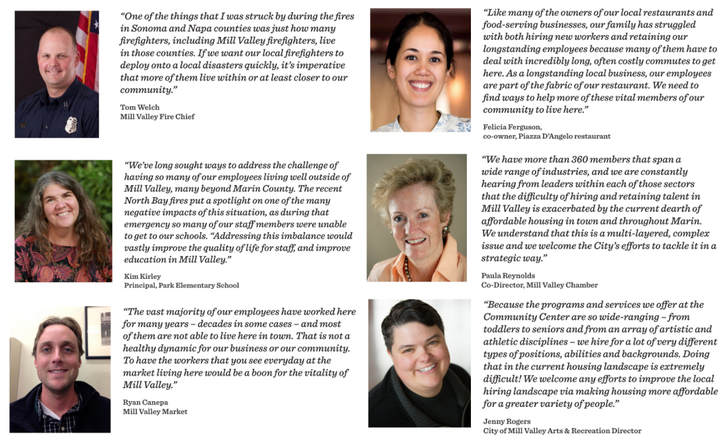Having that conversation, and identifying short-, medium- and long-term strategies to make sure that those vital contributors to our community can live here, was the driving goal behind the City of Mill Valley’s inaugural Housing Summit on Nov. 30. The lively event was a natural next step on a path that the City has been on since 2013, when the Mill Valley City Council approved its MV2040 General Plan and Housing Element two years later.
“When I took office four years ago, I only had one priority and that was to address affordable housing in our community,” then-Mayor Jessica Sloan told the packed house at the Community Center at the outset of the event. “Affordable housing is an issue here in Marin and across the entire state. It doesn’t just affect those who are struggling to afford to live in this county. It affects all of us: business owners struggling to hire, public safety officials whose personnel don’t live in our community, teachers who wish they could live here so they don’t have to race home everyday at 3pm to pick up their own kids.”
Progress to Date
City officials say the fee would generate approximately $375,000 annually. That revenue would go into a new affordable housing trust fund. What to do with that money was a central focus of the Housing Summit, and will continue to be going forward. The options include acquiring properties, assisting with the building of new dwelling units, building multi-unit projects, renovating existing developments or finding ways to subsidize rental rates for workforce housing, among others.
City Manager Jim McCann said the plan for 2018 is to bring a series of recommendations to the City Council, spanning the range of options, including new regulations, new programs and new projects. “We hope to build on this conversation and move forward with practical decisions in the months and years ahead,” McCann said.
Panel
Warner walked through a number of data points to explain the problem, including:
- 91% of the 4,600 jobs in Mill Valley – largely roles in the service and retail industries –are held by people who live outside the City. One-third of those people commute more than 25 miles each way.
- The cost of housing in Mill Valley far outpaces median income, with a person needing to make $117,000 per year to afford a two-bedroom apartment and $289,000 to afford a median-priced home. That prices out most people in retail jobs, teachers, firefighters, police officers, clergy, physical therapists and even some dentists.
- One-fifth of Mill Valley’s households make less than $50,000 per year, and 24 percent have children under 18. One-fifth of homes have a senior citizen as the head of the household. “Mill Valley is not a homogenous community, no matter what people think or say,” Warner said.
- One-fourth of seniors in Mill Valley are renters, and three-quarters of renters are low income.
The panel focused much of its attention on the following three topics (click each bullet to read more on each topic):
The Road Ahead
Thomas: Adopt tenant protection for renters; focus on second and junior second units; find a City-owned parcel and “build a jewel of an affordable infill project that could be a model and build goodwill for the future.”
Jordan: Creating a program to give landlords incentives to rent to those that need affordable housing; acquiring property onto which you can build affordable projects.
Staude: Pooling resources with other agencies and firms and to identify local champions for affordable housing.
Dorfman: We definitely need champions locally, but we should be open to looking outside of Mill Valley. There are other opportunities in the general vicinity.”
Osgood: Eliminate minimum parking requirements, especially in commercial corridors; be open to adjusting the rules on density – the number of dwelling units allowed per acre.
Capretta: Create more aggressive policies to disincentivize more of our housing stock from being reduced; the City becoming a buyer in the marketplace with affordable housing trust funds; incentivize developers with density bonuses and fee abatement.
Community Sentiment
“Part of it is dispelling the myth of who these people are who need affordable housing,” Jordan said. At some point, we have to get beyond the stereotypes. People who provide goods and services in our community can live in our community.”
“Sit down and ask yourselves: what’s in it for you as a community?” he added. “If we can provide these affordable opportunities, how does it enhance the community and make it have more long-term viability?”
Thomas said that the North Bay fires have opened people’s minds a bit on the subject. “People realized just how dependent we are on Sonoma County and our neighbors to the north. Teachers couldn’t get to work and our schools were closed as a result. People could see and feel the impact on them personally. That goes beyond just that it’s the right thing to do.”
The meeting was a constructive and informative start to a long conversation on potential solutions to the affordability crisis. As Mayor Sloan remarked, affordable housing “is an issue that really touches our community and one that we are committed to taking a stance on.” The event offered a chance for staff to share information and receive input from the community to allow staff to bring practical ideas to the City Council for discussion and direction.

